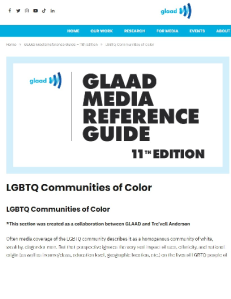
GLAAD Media Reference Guide, 11th Edition. GLAAD.
Keywords: Racial and Ethnic Disparities; Language/Terminology
Often media coverage of the LGBTQ community describes it as a homogenous community of white, wealthy, cisgender men. But that perspective ignores the very real impact of race, ethnicity, and national origin (as well as income/class, education level, geographic location, etc.) on the lives of LGBTQ people of color. According to a 2021 Cornell University study, for example, LGBTQ people are more likely than non-LGBTQ people to be people of color. And LGBTQ people of color face higher levels of discrimination than their white counterparts. Journalists should take an intersectional approach in their reporting, one that recognizes the multiplicity of experiences of LGBTQ people as informed by the specificity of their identities. Also note that just because a group of LGBTQ people share a race or ethnicity does not mean everyone in that group thinks or experiences life the same way.
File : pdf with 0.18 MB in size
LGBTQ Communities of Color